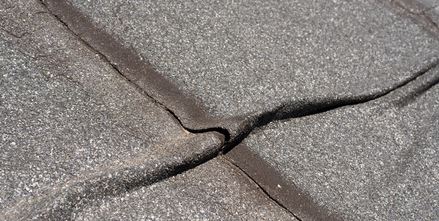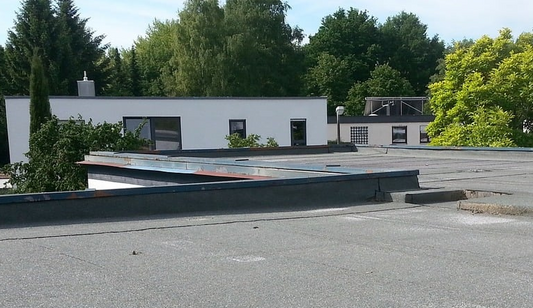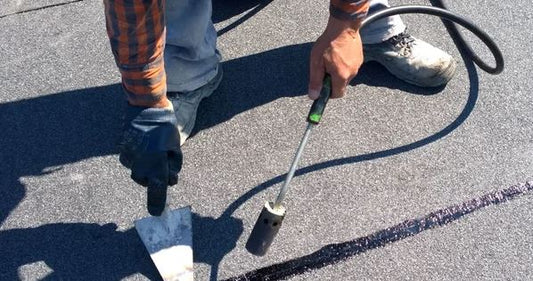To ensure your EPDM roof lasts longer and functions effectively, you'll need to keep up with routine maintenance. Inspect it biannually, especially after extreme weather, to catch issues like cracks or leaks early.
Keep drainage systems clear to avoid standing water, and regularly clean the roof with a gentle, non-abrasive cleaner to prevent damage from debris and dirt. Address any detected damages promptly using appropriate patches and seam sealants.
By actively maintaining the roof and solving small problems as they arise, you're safeguarding your investment and guaranteeing it stays in peak condition. Exploring more specific maintenance steps will guide you towards best practices for your roof's care.
Key Points
- Conduct semi-annual inspections, especially after severe weather, to identify and address wear, tears, or seam issues.
- Clean the roof regularly using a mild, non-abrasive cleaner to prevent buildup of debris and dirt.
- Ensure proper drainage by keeping gutters, downspouts, and drains clear to prevent ponding water.
- Repair punctures or tears promptly using an EPDM patch kit to maintain the integrity of the roofing material.
- Apply a UV protective coating periodically to shield the roof from sun damage and reduce heat absorption.
Understanding EPDM Roofing Materials
EPDM (ethylene propylene diene monomer) roofing is a durable synthetic rubber material widely favored for its resilience and cost-effectiveness.
You'll find it's highly resistant to weather, including extreme heat and cold, which makes it ideal for a variety of climates. It's also resistant to abrasion and UV radiation, ensuring it doesn't degrade easily under the sun's harsh rays.
This roofing type has a smooth, black surface that contributes to its ability to efficiently absorb heat during colder months while reflecting heat in the summer.
This dual nature helps you save on heating and cooling costs, making EPDM not only practical but also eco-friendly and economical in the long run.
Installation is straightforward because EPDM sheets are lightweight and can be installed either fully adhered, mechanically attached, or ballasted.
This flexibility allows for customization based on your specific roof's needs, which you'll appreciate if you're dealing with unique architectural features.
Furthermore, EPDM can last up to 50 years with proper care.
Its longevity, coupled with minimal maintenance requirements, means you'll enjoy a cost-effective roofing solution that doesn't sacrifice performance over time.
Regular Inspection Schedules
To maximize the longevity of your EPDM roof, you should establish a regular inspection schedule.
It's vital to check your roof at least twice a year—typically in spring and fall. This timing helps you catch any issues that have arisen from harsh weather conditions like winter storms or summer heat.
During these inspections, you'll want to look for signs of wear and tear such as cracks, blisters, or shrinkage.
Pay special attention to seams and edges where leaks are more likely to develop. Also, inspect flashings around penetrations and equipment installed on the roof. These areas are prone to gaps and deterioration over time.
Don't overlook your roof's drainage system.
Verify that gutters, downspouts, and drains are free from blockages. Standing water can be a serious threat to an EPDM roof, potentially leading to accelerated wear or even structural damage.
Consider keeping a roof inspection log.
Documenting your findings can help track the roof's condition over time and spot trends or recurring issues. If you're not comfortable performing these inspections yourself, it's wise to hire a professional.
Regular professional assessments can catch subtler issues that might escape untrained eyes, guaranteeing your roof's longevity and performance.
Cleaning Your EPDM Roof
Regularly cleaning your EPDM roof covering not only enhances its appearance but also extends its lifespan by preventing the buildup of debris and dirt that can cause damage over time.
It's vital to tackle this task with the right approach to avoid harming the roofing material.
Start by choosing a mild, non-abrasive cleaner. Avoid petroleum-based products or harsh chemicals, as they can deteriorate the rubber.
Mix your cleaner with water as directed, aiming for a solution that's strong enough to clean but gentle enough to preserve the integrity of your roof.
Use a soft-bristled brush or a mop to apply the solution. It's important to scrub gently; you're looking to dislodge unwanted particles without scuffing the roof surface.
Focus on areas that tend to collect more dirt, such as around any installations or protruding features.
Once you've scrubbed the roof, rinse it thoroughly with clean water to remove any residue.
A low-pressure hose works best for this—high pressure might damage the rubber.
Detecting and Repairing Leaks
Many leaks, if not promptly addressed, can quickly escalate into significant issues for your EPDM roof. You've got to be vigilant.
Start by inspecting your roof regularly, especially after severe weather. Look for signs of cracking, blistering, or cuts in the membrane. These can all be entry points for water.
If you spot a leak, don't panic. First, clean the area around the leak thoroughly; dirt and debris can hinder your repair efforts.
Once the surface is clean, dry it completely. For small punctures or tears, applying an EPDM patch is your best bet. You'll need an EPDM primer and a piece of EPDM membrane. Apply the primer to the damaged area and the patch. Once it's tacky, place the patch over the hole and press firmly to secure a tight seal.
For larger issues, it may be best to consult a professional. They can assess whether a more extensive section of your roofing needs to be replaced.
Managing Ponding Water
Addressing ponding water on your EPDM roof is crucial to maintaining its integrity and longevity.
This common issue, if ignored, can lead to significant problems such as accelerated aging of your roof material and increased susceptibility to leaks.
This is how you can effectively manage ponding water to guarantee your roof remains in top condition.
Firstly, it's critical to verify your roof has proper drainage.
Check if your drainage system is clear of debris and functioning correctly. You might need to clean out gutters and downspouts regularly, especially after heavy rainfalls or during fall when leaves are likely to block the passages.
Secondly, consider adjusting the slope of your roof.
Even a slight incline can greatly enhance water runoff and prevent water from pooling. This can be done during the initial installation or as part of a maintenance routine by adding tapered insulation or additional layers in low areas.
Lastly, regular inspections are key.
After every major storm or at least twice a year, walk your roof to identify any potential problem areas where water might accumulate. Early detection allows you to address issues before they escalate, saving you time and money in the long run.
Preventing and Treating Punctures
While preventing punctures on your EPDM roof, it's vital to be proactive in your approach.
Regular inspections are your first line of defense. You'll want to walk your roof carefully, looking for sharp objects or debris that might've blown onto the surface. It's wise to do this especially after heavy storms.
If you find punctures, don't panic. Small punctures can be dealt with easily if caught early.
Clean the affected area thoroughly, removing any dirt and debris. You'll need an EPDM patch kit — typically containing a piece of EPDM membrane and a special adhesive. Make sure the patch is larger than the puncture itself for a secure seal. Apply the adhesive as directed, then place the patch over the puncture, pressing down firmly to guarantee there are no air bubbles.
Checking and Sealing Seams
After you've managed punctures, it's important to check the seams of your EPDM roof next. Over time, seams can become a weak point, potentially allowing water to enter and damage the underlying structure.
Begin by carefully inspecting each seam for signs of wear, separation, or gaps. It's vital to tackle this before any moisture seeps in and creates bigger problems.
When examining your seams, look for any areas that appear lifted or aren't adhering properly. If you spot issues, you'll need to clean the affected areas thoroughly.
Use a broom or blower to remove debris, then wipe the seams with a cloth dipped in an EPDM cleaner. This preparation guarantees that the sealant you apply adheres well and provides effective waterproofing.
Next, apply a seam sealant specifically designed for EPDM roofs. Be generous and precise, covering the entire exposed seam.
After applying the sealant, use a seam roller to press down firmly along the sealed area. This helps the sealant bond effectively and eliminates any air pockets that could lead to future vulnerabilities.
Regularly checking and sealing seams extends your roof's lifespan substantially, safeguarding your home against leaks and moisture damage. Make this a part of your routine roof maintenance to keep your EPDM covering in top shape.
Dealing With Environmental Damage
Environmental factors like UV rays, hail, and heavy rain can wreak havoc on your EPDM roof.
To combat these elements, it's vital you take proactive steps to protect and maintain your roofing material.
Firstly, regular cleaning is essential.
Dirt and debris not only detract from your roof's appearance but can also retain moisture and exacerbate wear from UV exposure.
You'll want to gently wash your roof using a soft-bristled brush and a non-abrasive cleaner.
This simple action can markedly reduce potential damage from environmental factors.
Next, consider applying a UV protective coating.
This layer acts as a sunscreen for your roof, reflecting harmful rays and reducing heat absorption, which can degrade the rubber over time.
Applying this coating can extend the life of your roof and improve its overall performance.
Also, be vigilant about inspecting your roof after extreme weather events.
Hail can create punctures or tears, while heavy rains might lead to pooling that undermines the roof's integrity.
Early detection of such issues allows for timely repairs, preventing minor damage from escalating into major problems.
Professional Maintenance and Services
Beyond DIY care, hiring professional maintenance services for your EPDM roof can be a game changer.
While you're adept at handling basic upkeep, specialists bring in-depth expertise that guarantees your roof remains in top condition.
They're equipped to spot problems you might miss, applying preventative techniques that extend your roof's lifespan substantially.
- Thorough Inspections: Experts conduct detailed assessments to identify hidden damages or weak spots.
- Advanced Repairs: They use high-quality materials and state-of-the-art techniques not typically available to the average homeowner.
- Customized Maintenance Plans: Professionals can tailor a maintenance schedule based on your roof's specific needs and environmental factors.
- Warranty Preservation: Regular professional maintenance helps keep your roof's warranty intact, protecting your investment.
- Safety: They adhere to stringent safety standards, reducing the risk of accidents associated with DIY roof repairs.
Rounding Up
To maximize the lifespan of your EPDM roof, stick to a regular maintenance schedule. Inspect it frequently, clean it gently, and be vigilant about repairing leaks and sealing seams. Don't ignore punctures or ponding water, as they can lead to bigger issues. With these proactive steps, you'll guarantee your rubber roof remains in top condition for years to come.




